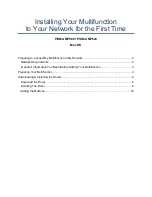
CHAPTER 2
2 - 32
2 . Controlling the automatic emission of the laser diode
The automatic emission mechanism (APC) of the laser diode is controlled by the laser driver IC,
ensuring that the laser diode emits light of a specific intensity.
When the laser forced emission signal (/LONO) goes ‘L’ or the image formation enable signal (/
ENBLO) and the /VOUT signal go ‘L’, the laser diode is turned on in keeping with the reference
voltage of the laser driver PCB.
The photodiode of the laser diode receives the laser light, and feeds it back to the control amplifi-
cation circuit of the laser driver IC for comparison against the current level determined by the
power adjustment circuit, thereby controlling the laser current flowing to the laser diode.
The machine uses an APC method in which its laser driver detects and controls, for each dot, the
intensity of light at all times as long a the laser diode remains ON.
3 . Controlling the horizontal synchronization
The ASIC generates the un-blanking signal inside it using the BD input signal (/BDIN) coming
from the BD PCB mounted to the laser/scanner assembly.
The ASIC causes the laser forced emission signal (/LONO) to go ‘L’ during the un-blanking period,
and the laser driver turns on the laser diode when the /LONO signal is ‘L’.
A small fixed mirror (BD mirror) is mounted in the optical path where the laser beam starts a scan,
and it is used to reflect the laser beam turned on by the /LONO signal and to detect it to the BD
PCB inside the laser/scanner assembly.
The BD PCB detects the laser beam, and generates the BD input signal (/BDIN), and sends the
output to the ASIC, which generates the horizontal sync signal (/BDO) based on the /BDIN signal
for use by the video controller.
Summary of Contents for LBP-2000
Page 36: ...CHAPTER 1 1 30 ...
Page 38: ...CHAPTER 1 1 32 ...
Page 150: ......
Page 199: ...CHAPTER 4 4 48 D PCBs 1 2 3 4 5 Figure 4 9 4 Printer Paper Feeder ...
Page 203: ......
Page 206: ...APPENDIX A 2 ...
Page 222: ...CANONINC ...
















































